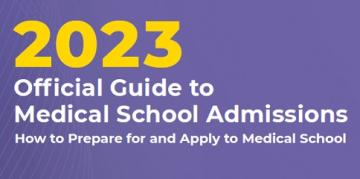
“When applying to medical school, it’s difficult not to transform yourself into a number—well, two numbers: your MCAT® score and GPA. [But] they are only two facets. The skills you develop before medical school will inform you for the rest of your life. And those numbers that got you into medical school? They never matter again.”
--Luke P. Burns, University of California, San Diego School of Medicine, class of 2018.
As you prepare to apply to medical school, you will make decisions about when and where to apply based on many factors: Should you take additional coursework? Re-take the MCAT exam? Take a gap year? If so, how should you spend it? The Official Guide to Medical School Admissions is a resource packed with information about navigating these decisions. It includes information about preparing for medical school, exploring medical career options, financing your education, how admissions decisions are made, and advice from current students and admissions officers.
The guidebook also includes national data and statistics. These data, from applicant scores to experiences, can help you and your pre-health advisor determine when you’re ready to apply to medical school. It may also dispel some of the common myths you may hear throughout the application process.
Here are a few of the many examples included in the guidebook:
Myth: Your MCAT® score matters most.
- Fact: Every applicant has their own story and medical schools accept students with a range of scores, attributes, and experiences. Having a “perfect MCAT score” and GPA does not guarantee you an acceptance to medical school. During the 2016 application cycle, an estimated 12% of applicants with the highest possible MCAT and GPA combination were not offered admission to medical school. Medical schools will evaluate you based on your MCAT score and GPA, but also by your letters of evaluation, personal statement, and experiences. Here’s another thing to consider: admissions officers are likely to place significance on “distance traveled.” This refers to any obstacles or hardships you’ve overcome to get to this point in your education, or any life challenges you’ve faced and conquered. Read more about distance traveled and holistic review in Chapter 8 of the Official Guide to Medical School Admissions.
Myth: More men than women are accepted to medical school.
- Fact: Half of medical students are women. In the 1976-1977 academic year, women made up just 24.7 percent of all medical school matriculants. Compare that with 2015-2016, when women made up almost half—47.8 percent—of the entering class [AAMC Data Book] and some schools accepted more women than men. You can view each school’s breakdown of their first year class in the Medical School Admission Requirements.
Myth: You should major in a science.
- Fact: You can major in anything. There’s no such thing as the “best” major. In fact, medical schools do not require applicants to have a specific major. There is very little difference in median total MCAT scores among those who major in the humanities, social sciences, and biological sciences. The AAMC FACTS table, “The MCAT Scores and GPAs for Applicants and Matriculants to U.S. Medical Schools by Primary Undergraduate Major, 2015-2016,” shows that students from a wide range of majors are accepted to medical school, as long as they have the basic science preparation. Learn more about choosing a major in Chapter 2 of the Official Guide to Medical School Admissions.
Myth: Most students go straight from college to medical school.
- Fact: Taking at least one gap year is the norm. More than half (59.9 percent) of 2015 matriculating medical students indicated in the AAMC’s “Matriculating Student Questionnaire” that there was a gap of at least one year between their college graduation and matriculation to medical school. Keep in mind, this does not mean it is the best choice for everyone, and how you choose to spend your gap year can make a big difference in how a medical school perceives that time off. Learn more about gap years.
Myth: Most medical students are in their early 20s.
- Fact: There is a wide variation of the ages of entering medical students. For the 2015 entering class, individuals were between 18 and 54 years of age at the time of expected matriculation. The applicants between 21 and 28 years of age when they were expected to matriculate totaled 47,482; the number of applicants under 21 was 499; and applicants over 28 numbered 4,569.
Myth: You can’t have a C on your transcript.
- Fact: One low grade will not ruin your chances. We know many applicants have a GPA of 3.75 or higher, roughly 100 medical students are accepted each year with a total undergraduate GPA below 2.75. See more national data like this in Chapter 9 of the Official Guide to Medical School Admissions.
Myth: Only wealthy students can afford medical school.
- Fact: Most students pay for medical school with loans. Medical school is expensive, but there are many resources and tools to help you, including loans, grants, and scholarships. Eighty-six percent of newly graduated MDs have medical school education loans, and 61 percent reported receiving some degree of help through scholarships, stipends, and grants (which you don’t have to repay). Learn more about financial aid resources and create a budget plan in Chapter 10 of the Official Guide to Medical School Admissions.
The data in the Official Guide to Medical School Admissions comes directly from the AAMC Data Warehouse, the AAMC Data Book, the American Medical College Application Service® (AMCAS®), the Medical College Admission Test® (MCAT®), and surveys conducted with entering and graduating medical students, such as the Graduation Questionnaire (GQ) and the Matriculating Student Questionnaire (MSQ). The data are comprehensively updated each year with the most current information available before it’s printed. Because it comes directly from the source, it is the most up-to-date and accurate information available.
Be sure to check out the AAMC Facts Tables for additional national data. For school-specific data, see the Medical School Admission Requirements.
